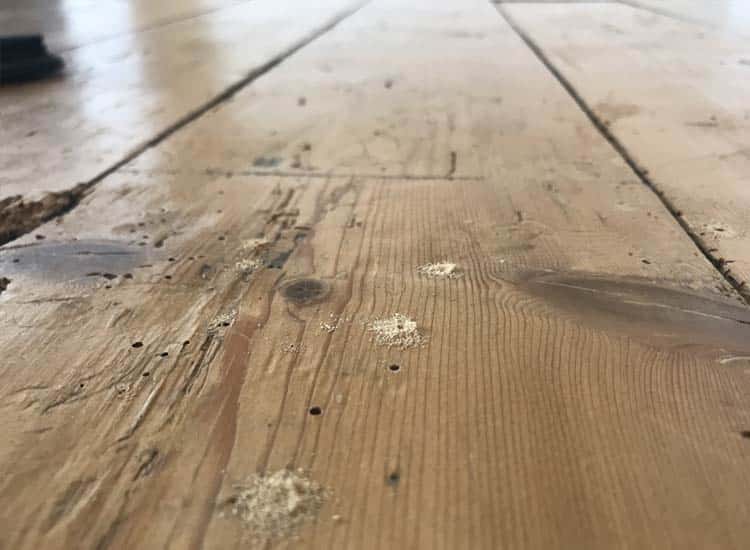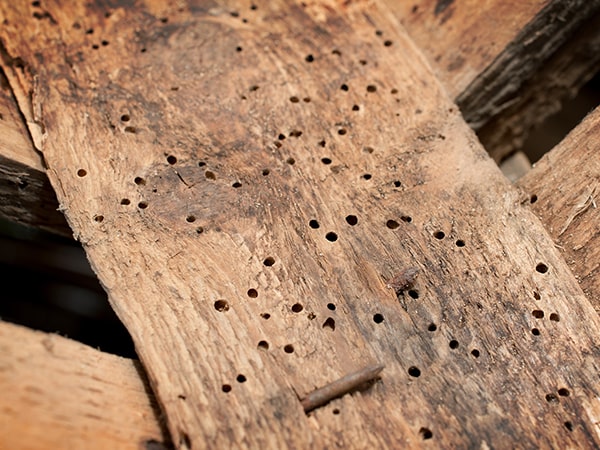Signs of Woodworm

Woodworm is an issue which is sometimes encountered by property owners which can unfortunately lead to the structural integrity of the timber becoming compromised. An infestation can result in long term damage to the structural timbers within a property. Some types of wood boring insects can inflict more damage to timber than others. Using a professional company to identify the correct treatment requirements should be your first consideration.
Knowing the signs of woodworm infestation can prevent serious damage to your property. Failure to identify a woodworm infestation early can result in timber becoming weakened which can impact the structural integrity of the timber within your property.
Tired of reading? Listen to this article!
There are several key signs which can help you to identify if your property is suffering from a woodworm attack, some of the key indicators are:
- Wood Tunnelling – Tunnels in the timber are caused by wood boring insects. These tunnels are within the wood, and often not identified until the wood has snapped or has been cut, exposing the end grain or timber below the surface.
- Exit Holes – These can be detected at any point throughout the year, but the holes tend to be formed between April and August the time of the flight season. These circular holes tend to be around 2mm in diameter however can be as large as 6mm in diameter.
- Presence of Beetles –Beetles within your property can be an indication that your property is suffering from a woodworm infestation. Dead or live adult beetles indicate that your property has or has had an attack by wood boring insects. A professional survey will determine if the attack is active or historic.
- Dust – Woodworm beetles will leave behind a dust (Frass) around or below the exit hole. This dust is caused by adult woodworm beetles emerging from the timber.
- Eggs – Identifying eggs is very difficult to do. Woodworms eggs are laid within cracks or old holes in the timber making it very unlikely that you will be able to identify them.
- Damaged or Weakened Flooring or other timbers – This may be a sign of your property suffering from a severe woodworm infestation. Crumbling wood tends to be caused by numerous exit holes and tunnelling below the surface which can be found affecting the timber.
How to Tell if Woodworm Are Active?
One of the most obvious signs of recent woodworm activity is fresh frass, which looks like sawdust, being evident on or around the timber from where woodworm has recently emerged.

Where You Can Find Woodworm?
Woodworm can be found in almost every type of wood surface including:
- Property beams
- Roofing timbers
- Structural timbers
- Flooring boards and floor joists
- Wooden surfaces which have been painted
- Furniture and wooden storage boxes
Should Wood Borers Always Be Treated?
The amount of damage caused by these insects depends on the size of the infestation and the species. Not every type of wood boring insect is equally harmful as different species prefer different types of timber. Some insects attack the timber in the forest or timber yard but not when in your property. Depending on the type of timber used in your property construction the damage can vary greatly. However, if left untreated for a long period of time woodworm can cause timber in your property to be weakened and can result in serious structural damage. The longer the issue remains untreated, the more holes will form on the timber as a result of the woodworm’s lifecycle continuing. More about woodworm (FAQ).

Woodworm Specialists
Still concerned that you’re suffering from a woodworm problem. Richardson and Starlings fully qualified surveyors will accurately diagnose the extent of the infestation and recommend the most suitable treatments if any treatment is required.
Our surveyors will:
- Initially determine whether the infestation is active and identify the type of wood boring species.
- Undertake tests to decide whether the timber needs to be removed, treated or repaired.
- Evaluate other areas to determine if they are also affected.
- Recommend the best woodworm treatments for your property
- Give you a survey report, and specification for treatment and a quotation if treatment is required
- Carry out a fully guaranteed treatment (30 year transferable guarantee).
Woodworm Treatment Survey Process
Our specialists will undertake a detailed survey of your property in order to provide you with the best possible form of treatment.
Our specialist’s treatment survey process is the initial assessment stage. This will be conducted over the phone which will provide you with an opportunity to discuss all the issues which you believe you have identified within your property. If our surveyor believes you may be suffering from a woodworm issue from the symptoms you have described a survey will then be arranged.
Our surveyor will visit your property to conduct a survey of your property’s woodworm problem. On completion of this survey, a written report will be issued. The report will highlight the extent of the attack and provide the recommended treatments which on completion will benefit from a 30-year guarantee for your peace of mind.
What To Do Next?
If you still suspect that you are suffering from a woodworm infestation after recognising the signs of woodworm, then we recommend that you seek the advice of a professional remedial treatment surveyor. This specialist can undertake a thorough survey to ensure that woodworm damage is identified and treated as quickly as possible.
Richardson and Starlings surveyors are members of the Property Care Association (PCA) and can carry out a survey on your behalf to accurately identify and advise the best treatment method.Have you noticed any signs of woodworm in your property? Get it inspected by a specialist property surveyor.
